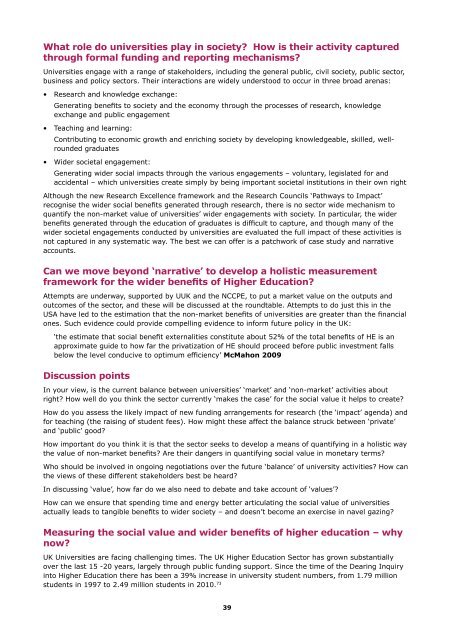Through a glass darkly Measuring the social value of universities
80096 NCCPE Social Value Report (2)
80096 NCCPE Social Value Report (2)
- No tags were found...
Create successful ePaper yourself
Turn your PDF publications into a flip-book with our unique Google optimized e-Paper software.
What role do <strong>universities</strong> play in society? How is <strong>the</strong>ir activity capturedthrough formal funding and reporting mechanisms?Universities engage with a range <strong>of</strong> stakeholders, including <strong>the</strong> general public, civil society, public sector,business and policy sectors. Their interactions are widely understood to occur in three broad arenas:• Research and knowledge exchange:Generating benefits to society and <strong>the</strong> economy through <strong>the</strong> processes <strong>of</strong> research, knowledgeexchange and public engagement• Teaching and learning:Contributing to economic growth and enriching society by developing knowledgeable, skilled, wellroundedgraduates• Wider societal engagement:Generating wider <strong>social</strong> impacts through <strong>the</strong> various engagements – voluntary, legislated for andaccidental – which <strong>universities</strong> create simply by being important societal institutions in <strong>the</strong>ir own rightAlthough <strong>the</strong> new Research Excellence framework and <strong>the</strong> Research Councils ‘Pathways to Impact’recognise <strong>the</strong> wider <strong>social</strong> benefits generated through research, <strong>the</strong>re is no sector wide mechanism toquantify <strong>the</strong> non-market <strong>value</strong> <strong>of</strong> <strong>universities</strong>’ wider engagements with society. In particular, <strong>the</strong> widerbenefits generated through <strong>the</strong> education <strong>of</strong> graduates is difficult to capture, and though many <strong>of</strong> <strong>the</strong>wider societal engagements conducted by <strong>universities</strong> are evaluated <strong>the</strong> full impact <strong>of</strong> <strong>the</strong>se activities isnot captured in any systematic way. The best we can <strong>of</strong>fer is a patchwork <strong>of</strong> case study and narrativeaccounts.Can we move beyond ‘narrative’ to develop a holistic measurementframework for <strong>the</strong> wider benefits <strong>of</strong> Higher Education?Attempts are underway, supported by UUK and <strong>the</strong> NCCPE, to put a market <strong>value</strong> on <strong>the</strong> outputs andoutcomes <strong>of</strong> <strong>the</strong> sector, and <strong>the</strong>se will be discussed at <strong>the</strong> roundtable. Attempts to do just this in <strong>the</strong>USA have led to <strong>the</strong> estimation that <strong>the</strong> non-market benefits <strong>of</strong> <strong>universities</strong> are greater than <strong>the</strong> financialones. Such evidence could provide compelling evidence to inform future policy in <strong>the</strong> UK:‘<strong>the</strong> estimate that <strong>social</strong> benefit externalities constitute about 52% <strong>of</strong> <strong>the</strong> total benefits <strong>of</strong> HE is anapproximate guide to how far <strong>the</strong> privatization <strong>of</strong> HE should proceed before public investment fallsbelow <strong>the</strong> level conducive to optimum efficiency’ McMahon 2009Discussion pointsIn your view, is <strong>the</strong> current balance between <strong>universities</strong>’ ‘market’ and ‘non-market’ activities aboutright? How well do you think <strong>the</strong> sector currently ‘makes <strong>the</strong> case’ for <strong>the</strong> <strong>social</strong> <strong>value</strong> it helps to create?How do you assess <strong>the</strong> likely impact <strong>of</strong> new funding arrangements for research (<strong>the</strong> ‘impact’ agenda) andfor teaching (<strong>the</strong> raising <strong>of</strong> student fees). How might <strong>the</strong>se affect <strong>the</strong> balance struck between ‘private’and ‘public’ good?How important do you think it is that <strong>the</strong> sector seeks to develop a means <strong>of</strong> quantifying in a holistic way<strong>the</strong> <strong>value</strong> <strong>of</strong> non-market benefits? Are <strong>the</strong>ir dangers in quantifying <strong>social</strong> <strong>value</strong> in monetary terms?Who should be involved in ongoing negotiations over <strong>the</strong> future ‘balance’ <strong>of</strong> university activities? How can<strong>the</strong> views <strong>of</strong> <strong>the</strong>se different stakeholders best be heard?In discussing ‘<strong>value</strong>’, how far do we also need to debate and take account <strong>of</strong> ‘<strong>value</strong>s’?How can we ensure that spending time and energy better articulating <strong>the</strong> <strong>social</strong> <strong>value</strong> <strong>of</strong> <strong>universities</strong>actually leads to tangible benefits to wider society – and doesn’t become an exercise in navel gazing?<strong>Measuring</strong> <strong>the</strong> <strong>social</strong> <strong>value</strong> and wider benefits <strong>of</strong> higher education – whynow?UK Universities are facing challenging times. The UK Higher Education Sector has grown substantiallyover <strong>the</strong> last 15 -20 years, largely through public funding support. Since <strong>the</strong> time <strong>of</strong> <strong>the</strong> Dearing Inquiryinto Higher Education <strong>the</strong>re has been a 39% increase in university student numbers, from 1.79 millionstudents in 1997 to 2.49 million students in 2010. 7339


